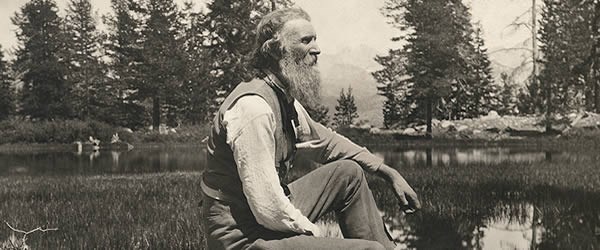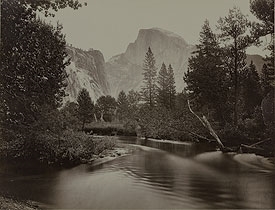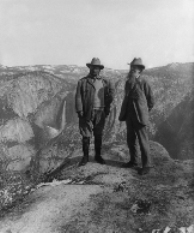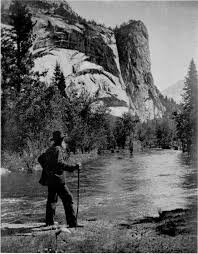 |
| John Muir looking over part of the Yosemite Valley (http://www.pbs.org/nationalparks/people/historical ()) |
"Plans to protect air and water, wilderness and wildlife are in fact plans to protect man"(Stewart Udall). John Muir understood this principle quite well as he dedicated his life to protecting nature. Not only did he protect nature, but he created national parks that helped preserve unique plants and animals that were found nowhere else. John Muir was born on April 21, 1838, in Dunbar, Scotland. He grew up with a strict moral code and harsh consequences if he disobeyed them. When his family immigrated to Wisconsin, his father put him into harsh work on their farm. It was there John read books and grew to love nature. As he read, he became more educated and began to understand the relationships people had with nature. He attended the University of Wisconsin, but dropped out in 1863 because he wanted more than a designated curriculum ("John Muir"). When John Muir left Wisconsin, he journeyed west to California. There he found Yosemite and the Sierra Nevada Range. He treasured the Yosemite Valley and sought to protect other natural environments like it. Therefore, he dedicated his life to protecting unique areas to preserve the beauty of nature. John had a deep compassion for nature and fought to save priceless environments for others. He did this by publicly voicing his opinion and influencing to others to protecting nature. John Muir's compassion and dedication to protecting natural environments for others inspired others to follow in his footsteps and help protect nature.
When John Muir explored and studied the Sierra Nevada mountain range, he also found vast numbers of sheep ravaging the lush grass and as a result affecting the natural wildlife. He felt compelled to protect the mountain range and Yosemite Valley.Unintentionally, John Muir found the Yosemite Valley. Originally, he planned to traveling to South America to study the jungles, but caught an illness in Florida that caused him to change his course of direction. He stumbled upon Yosemite while trekking northward up California. He heard of a vast mountain range and hiked through the valley in amazement. "It was California's Sierra Nevada and Yosemite that truly claimed him. In 1868, he walked across the San Joaquin Valley through waist-high wildflowers and into the high country for the first time. Later he would write: 'Then it seemed to me the Sierra should be called no the Nevada, or Snowy Range, but the Range of Light...the most divinely beautiful of all the mountain chains I have ever seen'"("The Yosemite"). When John Muir arrived in San Francisco, he heard about the renowned San Joaquin Valley and the Sierra Nevada. They soon would be one of his favorite places to roam and adventure, learning about the relationships of living creatures, from plants to animals. Later in his life, John Muir would become one of the most influential naturalists who fought to protect environments like the Sierra Nevada mountain range from industrial changes. On his campaign to preserve Yosemite area, he led the largest naturalist movement at the time. The government saw this and in turn, also supported Muir and decided to act, creating Muir's Yosemite National Park. "To preserve this unspoiled landscape, Muir urged the federal government to protect it. In 1890, Congress passed the Yosemite National Park Act with the intent that this "great natural wonderland would be preserved in pure wilderness for all time for the benefit of the people of the United States"(John Muir: A Brief Biography). Yosemite Valley is an unspoiled landscape that is untouched by industry, such as logging and mining. To preserve this, John Muir urged the government to intervene before people damaged the area by taking advantage of the resources. Not only did John Muir save the habitats of Yosemite, he saved it for other peoples use, to benefit other people who come to Yosemite. John Muir's compassion for nature is boundless. No matter where he went, he shared his compassion for nature with others. His benevolence for nature compelled him to do wonderful acts of benevolence and made a huge influence on the nation. He prevented vast amounts of deforestation and pollution by preserving nature through John Muir's compassion.
 |
| Yosemite with Half Dome in the distance. (http://www.pbs.org/wnet/americanmasters/episodes/j ()) |
Even as John Muir fought to protect nature, he didn't do it just for nature or his enjoyment of the environment. He helped create national parks for people's enjoyment and learning, so that they could experience and learn about the natural world. Articles John Muir wrote also included his purpose of protecting the parks for the people and the world. "In both these articles Muir's style rose to the impassioned oratory of a Hebrew prophet arraigning wickedness in high places and preaching the sacred duty of so using the country we live in that we may not leave it ravished by greed and ignorance, but may pass it on to future generations undiminished in richness and beauty"("John Muir"). John Muir did not only protect nature from self-indulgence, he shielded the environment so natural displays can be shown to the general public. This is a restful way, people could become more educated about their environment and feel moved to also protect them from destruction. Even though John Muir worked to protect Hetch Hetchy from people who sought to use the resources, they still groped for a prospect that they would be able to gain access to the trees and mountains."Sad to say, this most precious and sublime feature of the Yosemite National Park, one of the greatest of all our natural re-sources for the uplifting joy and peace and health of the people, is in danger of being dammed and made into a reservoir to help supply San Francisco with water and electricity by building a dam and flooding , thus flooding it from wall to wall and burying its gardens and groves one or two hundred feet deep"("The Yosemite"). The mayor of San Francisco claims that damming Hetch Hetchy, a valley that has a similar resemblance to the Yosemite Valley is the "best" course of action for the people." However, it would be removing a sanctuary of animals and people alike. Animals would not be able to live in a flooded valley and people cannot see the beauty of nature when it is destroyed by flooding. Therefore, John Muir tried to intervene and save Hetch Hetchy to preserve a home for both people and animals. John Muir didn't just preserve national areas to just sit in seclusion. He created the national parks to act as a sanctuary for both people and animals alike. As John Muir said, "Keep close to Nature's heart... and break clear away, once in awhile, and climb a mountain or spend a week in the woods. Wash your spirit clean"(John Muir).
 |
| Roosevelt and Muir at Glacier Point, Yosemite. (http://en.wikipedia.org/wiki/File:Muir_and_Rooseve ()) |
John Muir was a man who lived in the quiet countryside as a boy and yet, he still voiced his opinions publicly without shame. Speaking up in front of a crowd is not effortless, but a whole country? John Muir stood up to everyone in the nation to talk about nature because he was the voice that defended nature when it could not defend itself. John Muir talked in front of enormous crowds and influenced numbers of them as they listened intently on what he said. "He was a huge factor in influencing the thought of California and the thought of the entire country, so as to secure the preservation of those famous natural phenomena- wonderful canyons, giant trees, slopes of flower-spangled hillsides- which make California a veritable Garden of the Lord"(Neider). President Roosevelt even saw the admirable qualities inside John Muir. He described him as a well virtued man who loved nature and felt compassionate towards the destruction of it. Therefore, Muir intervened and was able to turn the entire country's opinion of nature upside down, in turn saving much of the country's natural ecosystems and turning into national parks. The articles Muir wrote were also influential as he voiced his opinions on protecting nature. He protected nature by speaking what nature could not show on it's own. "In this condition is the great open book of Yosemite glaciers today; its granite pages have been torn and blurred by the same storms that wasted the castaway book. The grand central chapters of the Hoffman, and Tenaya, and Nevada glaciers are stained and corroded by the frosts and rains, yet, nevertheless, they contain scarce one unreadable page; but the outer chapters of the Pohono, and the Illilouette, and the Yosemite Creek, and Ribbon, and Cascade glaciers, are all dimmed and eaten away on the bottom, though the tops of their pages have not been so long exposed, and still proclaim in splendid characters the glorious actions of their departed ice"("Yosemite Glaciers"). This is from when John Muir published his article in the Newspaper. From the above citation, the description of massive the glaciers grinding against the rough granite rock and creating unique landmarks is phenomenal. John Muir's description of Yosemite reveals how he sees Yosemite and other national parks like it. Not only does he capture the beauty, but he motivates you to also protect areas like it. This shows his eloquent speaking skills and persuasive description. John Muir may have grown up on a farm, but it didn't stop him from speaking up. John Muir acted as the voice of nature, speaking what it couldn't speak or act. John Muir defended the environment by speaking up for nature.
 |
| (http://www.yosemite.ca.us/library/matthes/john_mui ()) |
John Muir paved the way to protecting nature with compassion and fighting for nature. Even when life threw obstacles at him, Muir just climbed over or around them by fighting and speaking on nature's behalf.Even so, John Muir faced some challenges that he couldn't fight, such as Hetch Hetchy. When San Francisco came and tried to claim the crystal clear water of the Tuolumne River, Muir tried to intervene. Unfortunately San Francisco won. However, John Muir did not let that defeat him and clock his progress. Instead, he used it to fuel his progress and drive him harder to protect the rest of Yosemite. John Muir rose from nothing and defended something that was under threat from most of the countries industries. His writings invoked wonder in people that read his books and articles. People who read his writings compelled others to preserve the natural environments that surrounded them. John Muir inspired greatness in others through his papers, changing the nation's view on how to use or protect nature. Even politicians and industries that used natural resources changed because of what Muir did to protect the world's environments (John Muir: A Brief Biography). Even though John Muir died on December 25, 1914, He made an enormous influence on the world today. Many of the national parks across the country from Yosemite National Park to Yellowstone National Park were created by John Muir. His works as a naturalist are an important part of America's history. John Muir dedicated his entire life to preserving much of the world's environments. By protecting the environment, he prepared the world for generations to come. Therefore, let his work not go to waste. If John Muir had never worked this vigorously, then much of the world's beautiful natural playgrounds would have disappeared and will if we do not continue to protect our world's environments.
Works Cited
"John Muir: A Brief Biography." John Muir Biography. Sierra Club, n.d. Web. 25 Jan. 2015.
"John Muir." Dictionary of American Biography. New York: Charles Scribner's Sons, 1936.
Biography in Context. Web. 28 Jan. 2015.
"Keep close to Nature's heart... and break clear away, once in awhile, and climb a mountain or
spend a week in the woods. Wash your spirit clean"(John Muir).
Neider, Susan M. Wild Yosemite: Personal Accounts of Adventure, Discovery and Nature.
New York: Skyhorse Pub., 2007. Print.
"Plans to protect air and water, wilderness and wildlife are in fact plans to protect man"(Stewart
Udall).
"The Yosemite." American Decades Primary Sources. Ed. Cynthia Rose. Vol. 2: 1910-1919.
Detroit: Gale, 2004. 241-246. Biography in Context. Web. 28 Jan. 2015.
"Yosemite Glaciers." Environmental Issues: Essential Primary Sources. Ed. Brenda Wilmoth
Lerner and K. Lee Lerner. Detroit: Gale, 2006. 210-213. Gale Virtual Reference Library.
Web.31 Jan. 2015.
Page created on 2/13/2015 12:00:00 AM
Last edited 2/13/2015 12:00:00 AM
